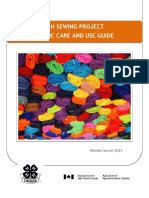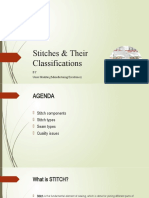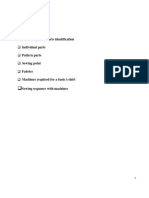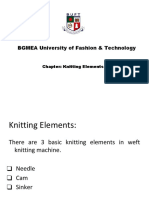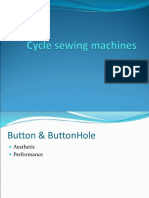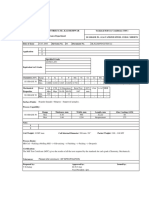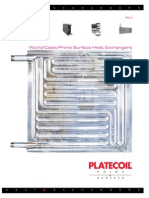Sewing Thread: Types of Sewing Thread Being Used in The Garments Industry of Bangladesh
Sewing Thread: Types of Sewing Thread Being Used in The Garments Industry of Bangladesh
Uploaded by
Abdur Rahim RumonCopyright:
Available Formats
Sewing Thread: Types of Sewing Thread Being Used in The Garments Industry of Bangladesh
Sewing Thread: Types of Sewing Thread Being Used in The Garments Industry of Bangladesh
Uploaded by
Abdur Rahim RumonOriginal Title
Copyright
Available Formats
Share this document
Did you find this document useful?
Is this content inappropriate?
Copyright:
Available Formats
Sewing Thread: Types of Sewing Thread Being Used in The Garments Industry of Bangladesh
Sewing Thread: Types of Sewing Thread Being Used in The Garments Industry of Bangladesh
Uploaded by
Abdur Rahim RumonCopyright:
Available Formats
Sewing Thread
Types of Sewing thread being used in the garments industry of Bangladesh
1.Polyester Corespun Thread 2.Spun Polyester Thread 3.Staple Spun Cotton Thread 4.Textured Polyester Thread 5.Polyester Cotton Corespun Thread 6.Trilobal Polyester Thread
Sewing Thread (Contd.)
1.Polyester Corespun Thread:
This type of thread is produced by spinning staple polyester fibre around a core of high tenacity continuous filament polyester in yarn-spinning operation. Two or more of these composite yarns are then twisted together to give the necessary size and tensile strength. e.g. Epic(Coats). Uses: Mainly used in topstitching of shirts, blouses, trousers, sportswear , jeans & work clothes.
Sewing Thread (Contd.)
Key Characteristics:
-
Exceptionally strong. The continuous filament core (Having high tenacity) provides superior strength while the staple polyester cover helps to protect the inner core from damage due to needle heat. Its resistance to abrasion helps ensure long seam life in a wide variety of materials. Fine threads can be used for delicate fabric without compromising on strength, thereby avoiding problems like seam pucker.
Sewing Thread (Contd.)
2. Spun Polyester Thread:
Staple polyester fibres are spun into polyester yarn. Then two or more of spun polyester yarns are twisted together to produce spun polyester thread. e.g. Astra (Coats)
Key Characteristics:
-
High tenacity of polyester ensures greater strength and thereby high abrasion resistance. Very least amount of shrinkage (less than 1%) compared to cotton thread.
of shirts, trousers, knitwear, jackets, blouses etc.
Uses: Mainly for overedging. Also used for general seaming
Sewing Thread (Contd.)
3. Staple Spun Cotton Thread:
Normally long staple cotton fibres are spun into cotton yarn. Then two or more ply of spun cotton yarn are twisted together to produce spun cotton thread. e.g. dymax (Coats)
Key Characteristics:
-
100% cotton thread have relatively low strength and elongation compared to those in synthetic thread , therefore they need relatively light sewing tension and high stitch densities. Very high amount of shrinkage compared to synthetic thread.
Sewing Thread (Contd.)
3. Staple Spun Cotton Thread:
- During sewing , cotton thread is not damaged at high temperature generated by needle.
- 100% cotton thread is mercerized (treatment with caustic solution under tension) to provide greater luster and higher strength. Uses: Mainly used in sewing cotton garments that are to be post dyed.
Sewing Thread (Contd.)
4. Textured Polyester Thread:
Made from textured continuous polyester filament. (Note- texturing means modification by applying crimp to the filament) . e.g. Gramax (Coats). Key features: - Provides high softness and comfort. - High extensibility and seam strength enhance higher seam security. Uses: Mainly used in next to the skin seams for high softness .e.g. underware, swimwear, babywear etc. Also widely used in overlocking and covering stitches for high extensibility and seam security.
-
Sewing Thread (Contd.)
5. Polyester Cotton Corespun Thread:
- Made of polyester filament in the core and staple cotton fibre which wraps polyester filament. Two or three plies of this yarn are twisted together to make thread. e.g. dual duty (Coats). Key features: - This thread has been developed to improve the properties cotton and to get the opportunities of both cotton and polyester fibre. - Very low shrinkage, good strength and cotton core protects poly core from needle heat and high ironing temperature. Uses: fine cotton denim shirts , outdoor wear etc.
Sewing Thread (Contd.)
6. Trilobal Polyester thread:
- Newly developed polyester fibre to improve the dullness of usual polyester fibre. -Trilobal poly is a multiple filament, twisted, high-sheen continuous fiber thread. It has the bright appearance of rayon or silk. Triangular shaped fibers reflect more light and give an attractive sparkle to textiles.
Uses: embroidery for garment.
You might also like
- Sewing Machine Tension Adjustment EbookDocument19 pagesSewing Machine Tension Adjustment Ebookfoin clarisseNo ratings yet
- 4h Sewing Project Fabric Dare and Use GuideDocument37 pages4h Sewing Project Fabric Dare and Use GuideJuan CubasNo ratings yet
- Chapter II Inventory Management SystemDocument29 pagesChapter II Inventory Management SystemLeandro Sampang76% (34)
- Price 3.7 Concrete Works (Class I)Document4 pagesPrice 3.7 Concrete Works (Class I)Zolkeplee BasirNo ratings yet
- Bucyrus Welding EcommendationsDocument108 pagesBucyrus Welding Ecommendationsvarthot100% (3)
- Selecting The Correct Sewing ThreadDocument5 pagesSelecting The Correct Sewing ThreaddieselakiasNo ratings yet
- Seams and Sewing Thread Characteristics in Denim FabricDocument11 pagesSeams and Sewing Thread Characteristics in Denim FabricAhmed ArshadNo ratings yet
- Stitch TypesDocument57 pagesStitch TypesOjasvi Agarwal100% (1)
- Seawing Room SubmisiionDocument22 pagesSeawing Room SubmisiionEhsanAhmedNo ratings yet
- Different Tools and Equipment in SewingDocument8 pagesDifferent Tools and Equipment in SewingAlyssa Marie ObcenaNo ratings yet
- How To Thread A Sewing MachineDocument3 pagesHow To Thread A Sewing MachineRestyNo ratings yet
- Warp KnittingDocument8 pagesWarp KnittingLavanya LazerNo ratings yet
- History and Developmet of Sewing MachineDocument15 pagesHistory and Developmet of Sewing MachineSahadat Hossen100% (1)
- Presentation On: Circular Knitting M/C: Prepared By: Tanvir Ahammed RanaDocument20 pagesPresentation On: Circular Knitting M/C: Prepared By: Tanvir Ahammed RanaMoinul Islam NasimNo ratings yet
- Review Knitting NeedlesDocument6 pagesReview Knitting NeedlesmohsinNo ratings yet
- Sewing DeffectsDocument11 pagesSewing DeffectsVeverley CarupoNo ratings yet
- Pressing Skills: Oregon 4-H Clothing Construction Fact Sheets: Basic Skills-Level 1Document5 pagesPressing Skills: Oregon 4-H Clothing Construction Fact Sheets: Basic Skills-Level 1udi969No ratings yet
- Sewing 01-Blindstitching With Groz-Beckert V-Needles PDFDocument4 pagesSewing 01-Blindstitching With Groz-Beckert V-Needles PDFfriendztoall4351No ratings yet
- Let's Learn To Knit: With Increase and DecreaseDocument20 pagesLet's Learn To Knit: With Increase and DecreaseluyawinNo ratings yet
- Sewing Machine - IntroductionDocument25 pagesSewing Machine - Introductionsonamanand2008No ratings yet
- 8.STITCHES & ClassificationDocument56 pages8.STITCHES & ClassificationUmer MushtaqNo ratings yet
- Featureso of Different Weaves 13.10Document28 pagesFeatureso of Different Weaves 13.10Atik U BhuiyanNo ratings yet
- Submitted To: Jarin Yasmin Asst. Professor Apparel Manufacturing - II City UniversityDocument14 pagesSubmitted To: Jarin Yasmin Asst. Professor Apparel Manufacturing - II City UniversityHasanuzzaman SumonNo ratings yet
- Types of Sewing MachinesDocument12 pagesTypes of Sewing MachinesShireen KhanNo ratings yet
- Warpknittedstructures 160415060405 PDFDocument6 pagesWarpknittedstructures 160415060405 PDFvsmirthuNo ratings yet
- Overlock: MachineDocument51 pagesOverlock: MachineShweta ChauhanNo ratings yet
- Parts of Sewing MachineDocument18 pagesParts of Sewing MachineKhurram Iftikhar100% (2)
- Sewing Machine Needle Types ChartDocument3 pagesSewing Machine Needle Types ChartTalha DarjiNo ratings yet
- Sewing Tools and Sewing Machine Operations: NtroductionDocument29 pagesSewing Tools and Sewing Machine Operations: Ntroductiongeorge odoyoNo ratings yet
- Types of Sewing Thread Reference ChartDocument6 pagesTypes of Sewing Thread Reference ChartMihiraNo ratings yet
- Textile ScienceDocument22 pagesTextile ScienceAbhinav VermaNo ratings yet
- Sewing, Sewing MachinesDocument56 pagesSewing, Sewing MachinesNikita JainNo ratings yet
- Jute Bag Sewing Machine 1Document1 pageJute Bag Sewing Machine 1Umesh PanchalNo ratings yet
- Sewing BedDocument15 pagesSewing BedSahadat HossenNo ratings yet
- Sewing ProbDocument18 pagesSewing ProbAminur RahmanNo ratings yet
- Study On Threading and Bobbin Winding For Single Needle Lock Stitch MachineDocument5 pagesStudy On Threading and Bobbin Winding For Single Needle Lock Stitch MachineHrithik Agarwala100% (1)
- T ShirtDocument12 pagesT Shirtmovie mail100% (1)
- Cut & Sew Knit WearDocument4 pagesCut & Sew Knit WearshponNo ratings yet
- Sewing Caddy Free PDF Sewing Pattern by Serger Pepper Only For So Sew EasyDocument12 pagesSewing Caddy Free PDF Sewing Pattern by Serger Pepper Only For So Sew Easysusana hatchatrjanNo ratings yet
- Unit I KnittingDocument41 pagesUnit I Knittingmkmuthumari2003No ratings yet
- Seam & StitchesDocument4 pagesSeam & StitchesKomal ChauhanNo ratings yet
- Structure and Design Final AssDocument20 pagesStructure and Design Final Assmike workuNo ratings yet
- Information On Different Needle Constructions and Needle ManufacturesDocument6 pagesInformation On Different Needle Constructions and Needle ManufacturesDilina De SilvaNo ratings yet
- Sewing MachinesDocument11 pagesSewing MachinesHomo CyberneticusNo ratings yet
- Basics of Knitting Weft KnittingDocument2 pagesBasics of Knitting Weft KnittingNikhil BhagatNo ratings yet
- Knitting File: August 7Document23 pagesKnitting File: August 7Nitika SharmaNo ratings yet
- Study of The Threading of Overlock MachineDocument4 pagesStudy of The Threading of Overlock Machineتحسین قائم خانی100% (1)
- Lab 4 Tappet Shedding IqbalDocument6 pagesLab 4 Tappet Shedding IqbalEngr Mujahid MehdiNo ratings yet
- Color FastnessDocument61 pagesColor FastnessSamyukthaNo ratings yet
- Knitting Machine Operator Flat Bed KnittingDocument51 pagesKnitting Machine Operator Flat Bed KnittingDirajen PMNo ratings yet
- Cutting SewingDocument9 pagesCutting SewingJeena Grace100% (1)
- Weft Knitting: MD - Azmeri Latif Beg M. SC in Textile Engineering Department of Textile Engineering, DIUDocument16 pagesWeft Knitting: MD - Azmeri Latif Beg M. SC in Textile Engineering Department of Textile Engineering, DIUaqsa imranNo ratings yet
- BGMEA University of Fashion & Technology: Chapter: Knitting ElementsDocument16 pagesBGMEA University of Fashion & Technology: Chapter: Knitting ElementsRatul HasanNo ratings yet
- Knitting LatestDocument39 pagesKnitting Latestgopica3448No ratings yet
- ButtonDocument9 pagesButtonLee100% (1)
- Button Hole StitchesDocument41 pagesButton Hole StitchesEruNo ratings yet
- Textilelearner - Blogspot.in-Knitting Action of The Compound Needle Warp Knitting Machine Knitting Action of The Compound NeedleDocument2 pagesTextilelearner - Blogspot.in-Knitting Action of The Compound Needle Warp Knitting Machine Knitting Action of The Compound NeedlernkmipNo ratings yet
- Sewing ProcessDocument28 pagesSewing ProcessRaja manimaranNo ratings yet
- Stitch Stars: Harry: Over 20 unofficial embroidery patterns for stitchy superfansFrom EverandStitch Stars: Harry: Over 20 unofficial embroidery patterns for stitchy superfansNo ratings yet
- Seven Nozzles - Catalogue - 2012-12+updatesDocument94 pagesSeven Nozzles - Catalogue - 2012-12+updatesPier GattiNo ratings yet
- Process Notes: Condensate Is CrudeDocument1 pageProcess Notes: Condensate Is CrudeYahya AljarokNo ratings yet
- Application of Pentron ProdDocument3 pagesApplication of Pentron ProdBabar AkbarNo ratings yet
- Acceptance Test of All Concrete Poles PDFDocument24 pagesAcceptance Test of All Concrete Poles PDFIsuru Kasthurirathne100% (1)
- Thermal Oil BoilerDocument4 pagesThermal Oil Boilerarjmandquest67% (3)
- Opr 201 Lean ManagementDocument1 pageOpr 201 Lean Managementjeet kumarNo ratings yet
- Sibu Composting ProjectDocument7 pagesSibu Composting Projectrokiahhassan100% (1)
- Gasification: (Turnw2E™ Gasification Enhanced Gasification Performance)Document2 pagesGasification: (Turnw2E™ Gasification Enhanced Gasification Performance)Arini Rizal100% (1)
- Qualification of Welding Procedure Specification FCDocument14 pagesQualification of Welding Procedure Specification FCmister pogi100% (4)
- IPE 4205: Quality Management: Rezaul Karim Nayeem Assistant Professor (IPE Discipline) Department of MPE, AUSTDocument16 pagesIPE 4205: Quality Management: Rezaul Karim Nayeem Assistant Professor (IPE Discipline) Department of MPE, AUSTnorbik idrisNo ratings yet
- Section VIII Div. 1 - UG-119 PDFDocument1 pageSection VIII Div. 1 - UG-119 PDFEsapermana RiyanNo ratings yet
- Design For Manufacturability For CNC MachiningDocument4 pagesDesign For Manufacturability For CNC Machiningviorelu99No ratings yet
- Ss Grade 50 - Galvanized Steel Coils & SheetsDocument1 pageSs Grade 50 - Galvanized Steel Coils & SheetshealgoseNo ratings yet
- Briones, Jomel S. Bsma - 1A Cost AccountingDocument1 pageBriones, Jomel S. Bsma - 1A Cost AccountingLorenzo PanchoNo ratings yet
- Pulp and Paper ProcessingDocument15 pagesPulp and Paper ProcessingWohooHohoNo ratings yet
- Regrind Mills - Challenges of Scaleup (Final)Document15 pagesRegrind Mills - Challenges of Scaleup (Final)Edwar Villavicencio JaimesNo ratings yet
- ME238 Advanced Machine Tools LabDocument2 pagesME238 Advanced Machine Tools Labganeshmd5No ratings yet
- Lean WarehousingDocument37 pagesLean Warehousingkevin21790No ratings yet
- Exel PLC - Supply Chain Management at Haus MartDocument27 pagesExel PLC - Supply Chain Management at Haus MartNeeraj GargNo ratings yet
- DocumentDocument5 pagesDocumentmaxz100% (1)
- PQR 1070 Certified Supplier ProgramDocument6 pagesPQR 1070 Certified Supplier ProgramMohammad AzamNo ratings yet
- IE UpdatedDocument58 pagesIE Updateddinhlap237100% (1)
- Synthetic Fuels GTL f1 Fischer Tropsch Process2588570496085257524Document8 pagesSynthetic Fuels GTL f1 Fischer Tropsch Process2588570496085257524Ishu Vohra100% (1)
- The Early History of PVC PipeDocument2 pagesThe Early History of PVC Pipeb1gm3nNo ratings yet
- Tranter Platecoil ApplicationsDocument12 pagesTranter Platecoil ApplicationsShafqat AfridiNo ratings yet
- Steam Assisted FlareDocument2 pagesSteam Assisted FlareNurul Atiqah Ahmad KamalNo ratings yet

